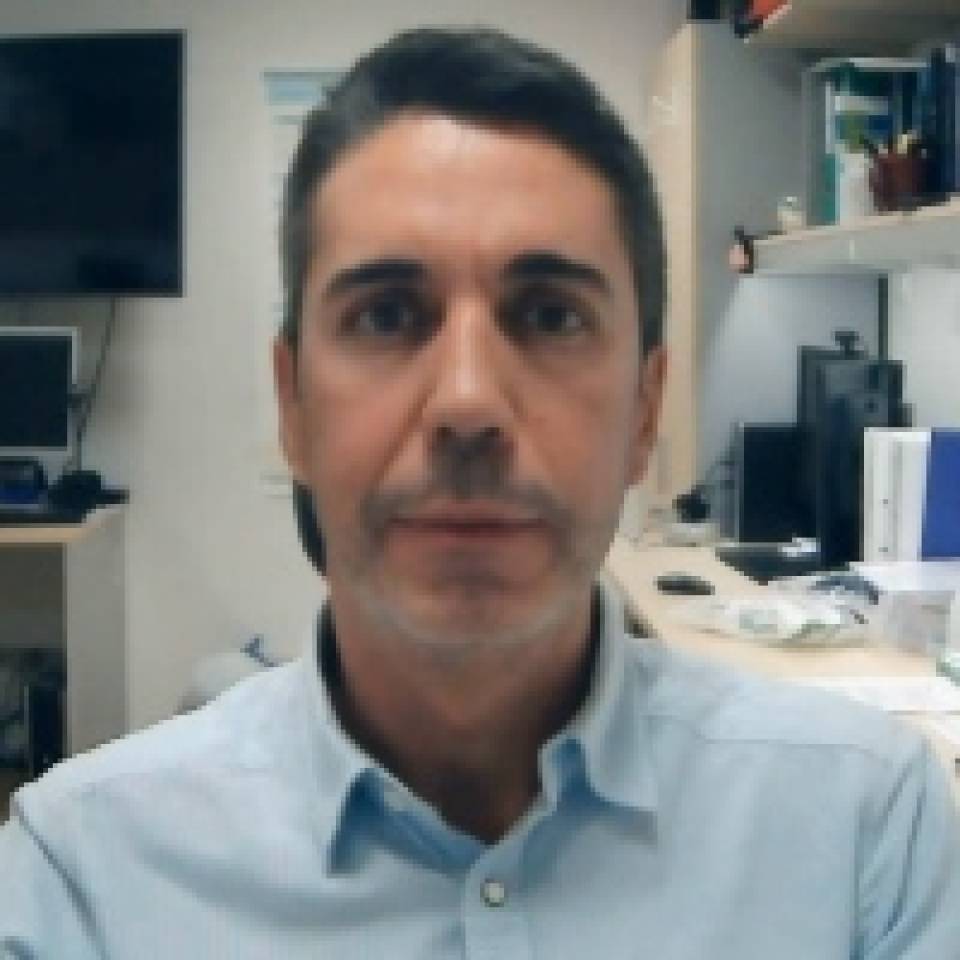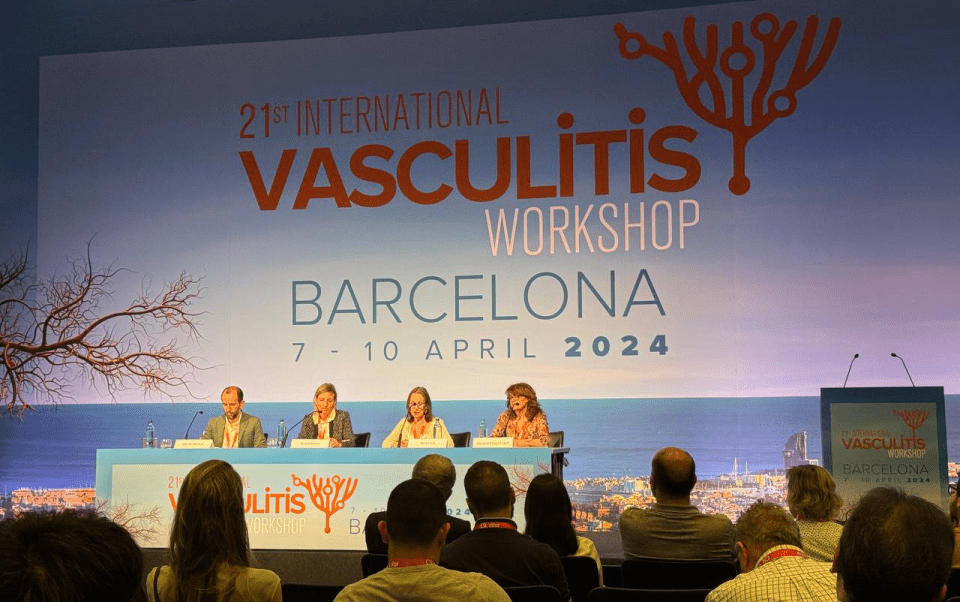- What is it?
- Causes and Risk factors
- Symptoms
- Diagnosis
- Treatment
- Evolution of the disease
- Living with the disease
- Research
- Frequently Asked Questions
-
La enfermedad en el Clínic
-
Equipo y estructura
Frequently Asked Questions about Vasculitis
Vasculitis is a disease that affects the blood vessels by causing inflammation of their walls, which leads to their occlusion (resulting in a lack of blood supply) or rupture (resulting in bleeding). Not all forms of vasculitis are the same, they may produce inflammation in different types (arteries, veins or capillaries) and sizes of blood vessel, which causes rather different diseases.
While some vasculitides are due to different infections (such as hepatitis B and C viruses), the cause of most types of vasculitis is unknown and therefore they are called primary or idiopathic (with no known cause) vasculitides. There seems to be some degree of genetic predisposition to developing vasculitis and there are signs it may be triggered by certain infections or hormonal or environmental stimuli, although these stimuli have not yet been identified.
Even though there may be a genetic predisposition for vasculitis, in general, it is a group of diseases that are not passed down from parents to children.
While the different types of vasculitis usually require intense treatment with corticosteroids and other immunosuppressants that must be administered for long periods (e.g., 2–5 years), most patients can eventually stop taking them. However, some patients will require chronic or extended treatment (normally at low doses), with some even requiring high doses and changes to their therapy because they have a more active and treatment-resistant disease. Vasculitides known to be the result of an infection are easily cured once the infection is treated successfully.
Yes, vasculitis may leave irreversible aftereffects if tissues are damaged before starting treatment (e.g., neurological, visual or respiratory problems or kidney failure). Some aftereffects may be reversible if the vasculitis does not destroy tissue in the affected organs. It is therefore of the utmost importance to avoid any delays in the diagnosis and start of treatment, and if in doubt, patients must be referred to a specialised centre as soon as possible.
For women, it depends on the type of vasculitis, the degree of activity, which organs are affected and the immunosuppressant therapy they are taking. Each case must be assessed on an individual basis by the healthcare team and a unit specialising in high-risk pregnancies. Both men and women who are receiving stable doses of certain medications as part of maintenance treatment, and while the disease is under control (in remission), should either stop taking the medicine or change it for a safer one that is more compatible with pregnancy. These cases must also be assessed individually and a few months before trying to get pregnant by the healthcare team and a unit specialising in high-risk pregnancies.
A biopsy is recommendable in most cases to verify the diagnosis and avoid administering unnecessary immunosuppressant treatments in the event of a potentially incorrect diagnosis (if made without a biopsy). In certain types of vasculitis, such as Takayasu’s arteritis or polyarteritis nodosa, in which a biopsy is difficult or unattainable, then a combination of the clinical presentation and vascular imaging studies, which reveal the characteristic arterial lesions of these forms of vasculitis, may be enough to make a diagnosis.
GCA is treated with corticosteroids such as prednisone, typically with an initial dose of 60 mg/day (or 1 mg/kg/day) for 1 month. In cases that course with severe complications, such as eye (vision loss or double vision) or neurological problems (strokes), high doses of intravenous methylprednisolone are indicated for 3 days, followed by prednisone at the dosage indicated above. The dose is then progressively reduced as per standard clinical practice schedules and guidelines. The gradual reduction until the complete withdrawal of the medication tends to take 2–5 years in most patients. Some cases require other medicines, such as methotrexate (weekly) and more recently tocilizumab (a biological agent that blocks interleukin-6), because the dose of prednisone cannot be reduced.
TKA is treated with corticosteroids such as prednisone, with an initial dose of 60 mg/day (or 1 mg/kg/day) for 1 month, and methotrexate, at a dose of 15–20 mg/week (or 0.3 mg/kg/week). The prednisone dose is then progressively reduced as per standard clinical practice schedules and guidelines, while some patients may reduce the dose and eventually stop taking the medications after a few years (at least 3–5 years). However, one third to half of all patients may experience flare-ups upon decreasing the dose of prednisone and even methotrexate may not prove effective. These patients are usually prescribed other medications such as tocilizumab (anti-interleukin-6), etanercept or infliximab (both anti-TNF agents), which have proved effective in the control of vasculitis and when discontinuing or reducing the dose of prednisone.
PAN is treated with corticosteroids such as prednisone, using an initial dose of 60 mg/day (or 1 mg/kg/day) for 1 month. The prednisone dose is then progressively reduced as per standard clinical practice schedules and guidelines, while some patients may reduce the dose and eventually stop taking the medication after a few years (at least 2 years). If a vital organ is affected at the time of diagnosis (e.g., the brain, heart, intestines or kidneys), then coadministration of monthly cyclophosphamide injections is recommended for 6–12 months as a remission induction therapy. After completing the course of cyclophosphamide, it should be replaced with azathioprine or methotrexate as part of maintenance therapy. If the prednisone dose cannot be reduced or traditional immunosuppressants are ineffective, the dose of prednisone should be increased and different immunosuppressants tried.
The treatment for KD should be started as early as possible in order to minimise any damage to the coronary arteries, which tends to develop late on. This involves the administration of high-dose aspirin (acetylsalicylic acid) and intravenous gamma globulins (human proteins with an antibody function). The administration of intravenous corticosteroids may be indicated in certain cases. Symptoms generally improve soon after starting the treatment, which tends to last for around 12 days.
GPA is treated with corticosteroids such as prednisone, at an initial dose of 60 mg/day (or 1 mg/kg/day) for 1 month, combined with weekly doses of methotrexate if vital organs are not affected (e.g., the kidneys, lungs, brain, heart or intestines). In cases where vital organs are involved, recommendations are to use intravenous methylprednisolone at high doses for 3 days, plasma exchange (optional, based on the severity of each case) and monthly cyclophosphamide injections for approximately 6 months as a remission induction therapy. This latter group of patients can also be treated with rituximab injections (instead of cyclophosphamide), for example, two doses in 2 weeks. After the first month, the prednisone dose is progressively reduced in line with standard clinical practice schedules and guidelines, while some patients may reduce the dose and eventually stop taking the medication after a few years (although the total duration cannot be predicted). In patients receiving cyclophosphamide, after completing the course it should be replaced with azathioprine or methotrexate as part of maintenance therapy. Those treated with rituximab should receive maintenance treatment every 6 months. Whenever the prednisone dose cannot be reduced or traditional immunosuppressants are ineffective, the dose of prednisone should be increased and different immunosuppressants or biological agents tried.
MPA is treated with corticosteroids such as prednisone, at an initial dose of 60 mg/day (or 1 mg/kg/day) for 1 month, and since it usually affects vital organs (such as the kidneys or lungs) it may also be treated with high doses (in severe cases) of intravenous methylprednisolone for 3 days, plasma exchange (optional, depending on the severity of each case) and monthly cyclophosphamide injections for approximately 6 months as a remission induction therapy. These patients can also be treated with rituximab injections (instead of cyclophosphamide), for example, two doses in 2 weeks. If no vital organs are involved, azathioprine or methotrexate can be added to the initial prednisone treatment. After the first month, the prednisone dose is progressively reduced as per standard clinical practice schedules and guidelines, and some patients may reduce the dose and eventually stop taking the medication after a few years (although the total duration cannot be predicted). In patients receiving cyclophosphamide, after completing the course it should be replaced with azathioprine or methotrexate as part of maintenance therapy. Those treated with rituximab should receive maintenance treatment every 6 months. Whenever the prednisone dose cannot be reduced or traditional immunosuppressants are ineffective, the dose of prednisone should be increased and different immunosuppressants or biological agents tried.
EGPA is treated with corticosteroids such as prednisone, using an initial dose of 60 mg/day (or 1 mg/kg/day) for 1 month. The prednisone dose is then progressively decreased according to standard clinical practice schedules and guidelines, while some patients may reduce the dose and eventually stop taking the medication after a few years (but the total duration cannot be predicted). If no vital organs are affected at the time of diagnosis (e.g., the brain, heart, intestines or kidneys), then coadministration of monthly cyclophosphamide injections is recommended for 6–12 months as a remission induction therapy. After completing the course of cyclophosphamide, it should be replaced with azathioprine or methotrexate as part of maintenance therapy. Whenever the prednisone dose cannot be reduced or traditional immunosuppressants are ineffective (because either the asthma or vasculitis worsen), the dose of prednisone should be increased and different immunosuppressants or biological agents tried, of which mepolizumab is known to have a beneficial effect.
The treatment of choice for IgAV, which only affects the skin or the skin and joints, is rest and non-steroidal anti-inflammatory agents (ibuprofen). When large areas of skin are involved, the intestines or kidneys are affected, or the clinical symptoms progress and worsen, then corticosteroids such as prednisone are indicated. The initial dose, its reduction and the use of traditional immunosuppressants should be determined on an individual basis and in line with standard clinical practice schedules and guidelines.
The treatment of choice for cryoglobulinaemic vasculitis (with no known cause) is prednisone. Depending on the severity, cyclophosphamide or rituximab may also be initiated as part of remission induction therapy.
Apart from corticosteroids such as prednisone at high initial doses (60 mg/day or 1 mg/kg/day) for 2–4 weeks, the treatment of choice includes the medicine or medicines that best control or eliminate the viral infection. The amount of prednisone should be reduced more quickly (in a few months) until it can be discontinued or decreased to the minimum dose required to control the symptoms.
Systemic forms of vasculitis are inflammatory diseases that involve an inherent risk that the inflammation itself could accelerate the process of atherosclerosis. As such, patients with vasculitis must take on healthy habits to minimise cardiovascular risk factors; it is essential they do not smoke or drink alcohol and follow a healthy diet that is low in fat and sugar and with very little or no salt (to improve blood pressure, fluid retention and address any increased appetite associated with the corticosteroids).
Patients with active vasculitis or who are receiving an intense initial treatment (to induce remission) are advised not to get any vaccinations. Patients whose vasculitis is under control (in remission) with low or stable doses of prednisone or other immunosuppressants may receive particle or inactivated vaccines, but not necessarily live, attenuated vaccines, the administration of which must be assessed on an individual basis.
Fever in patients with vasculitis, and who are receiving corticosteroid therapy and/or other immunosuppressants, if over 38 °C or accompanied by a decline in their general condition, should be considered a potentially serious infectious situation. In such cases, patients must go to an emergency department or their usual healthcare team immediately to assess whether they require antibiotic therapy.
Substantiated information by:




Published: 30 November 2018
Updated: 30 November 2018
Subscribe
Receive the latest updates related to this content.
(*) Mandatory fields
Thank you for subscribing!
If this is the first time you subscribe you will receive a confirmation email, check your inbox


